Traditional Dances of Onam festival
Read this article to know all the details of the Onam dances.Onam is a very important festival of the state of Kerala in India. There are many traditional dances that are performed specially during this festival. The dances are Kummattikali, Kaikottikali, Puli Kali, Kathakali and Thumbi Thullal.
Onam is one of the most important festivals for the people of Kerala. The festival signifies the time for unity and people also believe that the legendary King Mahabali makes a visit to each Keralite house on this day. This festival lasts for ten days, the tenth day (Thiruvonam) being the most important day. There are many celebrations that take place during Onam some of them being dances, a grand feast, traditional games, snake boat races and pookalam. There are five traditional dances that are performed during Onam festival. They are Kathakali, Kaikottikali, Kummatikali, Pulikali and Thumbi Thullal. Some of these dances are performed only by the women folk whereas some of them are performed only by the men folk. All the dances are unique in its own way with rare costumes and dance steps.Onam dances and art forms
1. Kaikottikali - 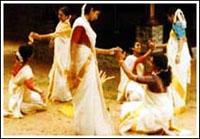 Kaikottikali is the most important dance of Onam festival in Kerala. The dance is also known as Thiruvathirakali since the dance is also performed on Thiruvathira. It is a graceful dance mostly performed by middle aged women in a circular fashion (clockwise and anti-clockwise) around a decorated pookalam (rangoli) design. A nilavilakku (a huge coconut-fed oil lamp) is also placed in the centre of the pookalam. Usually, around eight to ten women take part in the dance. The costume for Kaikottikali is simple which includes the traditional Kerala set sarees which are white in colour and have golden borders. The hair is tied up in a bun with fresh jasmine flowers attached to the hair which enhances the beauty of the dancer. They also wear a few items of gold jewellery. Usually the song for the dance is sung by a set of people on the mike rather than keeping it on a tape. Sometimes the dancers themselves sing the song. They sing and dance to the rhythm of clapping hands. The dance does not involve vigorous movements and is a gentle dance with a lot of importance given to facial expressions. The women almost sway like the breeze in gentle bends downwards, sideways and at times keep moving in the circle from one fellow dancer to the other to share a few claps with them. Enough practice is required before the dance is performed in public as it has to be done co-ordinately with the claps also done in unison. This dance is sometimes performed as a ritual by married women (for the well being of their husbands) and by unmarried women (to get good husbands). Sometimes men also participate in the dance as seen in some parts of the Malabar coast.
Kaikottikali is the most important dance of Onam festival in Kerala. The dance is also known as Thiruvathirakali since the dance is also performed on Thiruvathira. It is a graceful dance mostly performed by middle aged women in a circular fashion (clockwise and anti-clockwise) around a decorated pookalam (rangoli) design. A nilavilakku (a huge coconut-fed oil lamp) is also placed in the centre of the pookalam. Usually, around eight to ten women take part in the dance. The costume for Kaikottikali is simple which includes the traditional Kerala set sarees which are white in colour and have golden borders. The hair is tied up in a bun with fresh jasmine flowers attached to the hair which enhances the beauty of the dancer. They also wear a few items of gold jewellery. Usually the song for the dance is sung by a set of people on the mike rather than keeping it on a tape. Sometimes the dancers themselves sing the song. They sing and dance to the rhythm of clapping hands. The dance does not involve vigorous movements and is a gentle dance with a lot of importance given to facial expressions. The women almost sway like the breeze in gentle bends downwards, sideways and at times keep moving in the circle from one fellow dancer to the other to share a few claps with them. Enough practice is required before the dance is performed in public as it has to be done co-ordinately with the claps also done in unison. This dance is sometimes performed as a ritual by married women (for the well being of their husbands) and by unmarried women (to get good husbands). Sometimes men also participate in the dance as seen in some parts of the Malabar coast.
2. Thumbi Thullal - 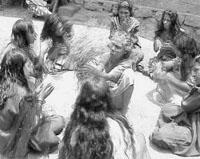 Thumbi Thullal is a folk dance performed by women on the occasion of Onam festival. In this dance also, the women sit in a circle around a person who sits in the centre of the circle holding a bunch of leaves called Thumba (the leaves of the thumbapoo) leaves. This person is called as 'Thumbi' (means dragon fly in Malayalam). About six to seven women take part in Thumbi Thullal wearing their traditional clothes. The person in the centre is the one who sings the song in her melodious voice while the women surrounding her will sway, clap and move to the tune. The song first begins with a slow speed which gradually keeps rising to a high tempo. The dance ends when the tempo of the song again decreases back to how it started. The lady in the centre is the leader of the group and she dances in such a way that she will look like a possessed woman. This art form is rarely performed nowadays and is fast on extinction.
Thumbi Thullal is a folk dance performed by women on the occasion of Onam festival. In this dance also, the women sit in a circle around a person who sits in the centre of the circle holding a bunch of leaves called Thumba (the leaves of the thumbapoo) leaves. This person is called as 'Thumbi' (means dragon fly in Malayalam). About six to seven women take part in Thumbi Thullal wearing their traditional clothes. The person in the centre is the one who sings the song in her melodious voice while the women surrounding her will sway, clap and move to the tune. The song first begins with a slow speed which gradually keeps rising to a high tempo. The dance ends when the tempo of the song again decreases back to how it started. The lady in the centre is the leader of the group and she dances in such a way that she will look like a possessed woman. This art form is rarely performed nowadays and is fast on extinction.
3. Kummatikali - 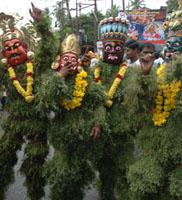 Kummatikali is also similar to Puli kali as in that this art form also contains colourful masked people but the difference is that they don't dress up like tigers. Infact the most interesting factor of Kummattikali is the heavily clad performers wearing unique costumes. This dance derives its name from a long stick of agricultural produce called Kummattikali which is also used by the dancers during the performance. Kummattikali is commonly performed in Trichur and Palghat districts of Kerala during the festival of Onam (on Thiruvonam). Kummattikali is actually a devotional form of art in which the performers dance to please the gods and goddesses. It is usually performed by men whose costumes are like skirts that are woven using plaited grass. The whole body is sometimes covered with a lot of grass and leaves. The face is also covered with imposing wooden masks that are highly decorated with paintings representing characters from the Hindu mythology usually from the epic, Ramayana. Some of the characters that are depicted include Lord Hanuman, Lord Rama, an old lady called 'thamma' and demons. The mask itself is made of saprophyte, jack fruit tree, Alstonia scholaris, hog plum tree or coral tree. It is very expensive to make these masks which are prepared months before the actual show. The artists will have the look of a person who has an open mouth without any tooth. This is achieved using 'talla' which is attached on the outside of the mask.
Kummatikali is also similar to Puli kali as in that this art form also contains colourful masked people but the difference is that they don't dress up like tigers. Infact the most interesting factor of Kummattikali is the heavily clad performers wearing unique costumes. This dance derives its name from a long stick of agricultural produce called Kummattikali which is also used by the dancers during the performance. Kummattikali is commonly performed in Trichur and Palghat districts of Kerala during the festival of Onam (on Thiruvonam). Kummattikali is actually a devotional form of art in which the performers dance to please the gods and goddesses. It is usually performed by men whose costumes are like skirts that are woven using plaited grass. The whole body is sometimes covered with a lot of grass and leaves. The face is also covered with imposing wooden masks that are highly decorated with paintings representing characters from the Hindu mythology usually from the epic, Ramayana. Some of the characters that are depicted include Lord Hanuman, Lord Rama, an old lady called 'thamma' and demons. The mask itself is made of saprophyte, jack fruit tree, Alstonia scholaris, hog plum tree or coral tree. It is very expensive to make these masks which are prepared months before the actual show. The artists will have the look of a person who has an open mouth without any tooth. This is achieved using 'talla' which is attached on the outside of the mask.
The performers of Kummattikali dance to the tunes of a bow-like stringed musical instrument called onavillu. Kummatikali people move from house to house on the occasion of Onam to entertain people and also to collect something in cash or kind such as rice, jaggery or small gifts. Infact, in olden days, they used to move from one village to another village during Onam. Children really enjoy watching the dances of these performers. Sometimes the beats of the instrument makes an eerie feeling in the atmosphere. Kummattikali does not need much practice or grand training for being performed. It is a folk dance form which can be learnt on-the-go by looking at the other participants or by just moving yourself in a devotional manner according to the rhythm of the beats. The performance usually starts in the afternoon and goes on till sunset. One person from the group who is also the leader will sing the song for the dance. Those who are wearing the coloured masks are not supposed to sing along with the leader. In earlier days, only people from the Nair community in Kerala used to perform Kummattikali but now this has changed and anyone from any caste is allowed to participate in it. Even non-Hindus come forward to take part in the art form which helps to foster communal harmony.
4. Puli kali - 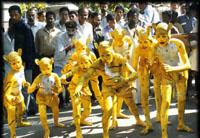 Puli kali is also known as Kaduvakali. It is mainly performed on the fourth day (Naalam Onam) of Onam festival (two days after Thiruvonam) mostly in Trichur and Palghat districts of Kerala. Puli Kali is a recreational folk art in which people paint their bodies with colourful designs of a puli (tiger) and dance on the streets to the rhythmic beats of traditional instruments called udukku, chenda and thakil. The face of the dancers are also covered with masks of tigers. Many people gather along the streets to watch these dances. The body of the dancers are painted in bright colours of yellow, red and black. This dance needs some training before it is enacted in front of the public. The people who perform Puli kali have a lot of patience as the make up of this dance is really strenuous which has to be one day before the actual performance itself. Two or three coatings are given to the paintings in order to enhance and brighten them. Each of the coatings take more than two hours to dry up after application. Before painting, the performers have to first shave their body and get rid of the hair. The paint used for making the designs are also toxic in nature which creates a burning sensation especially if it touches the eye by mistake. In olden days, each and every intricate part of the tiger used to be painted on the body and face of the artiste. But in today's world, some performers who are not ready to go through this strenuous journey use ready made masks, teeth, tongue and beards. A broad belt filled with jingles is also worn around the waist which the performers keep shaking to make noise. Children enjoy watching these performers dance and walk like tigers to the beats of the instruments. Some of the spectators also join the artistes to act like tigers and dance with them. Sometimes the artistes also pounce like a tiger to depict how a real tiger would try to catch its prey. One person in the group acts like a hunter who tries to catch the tigers. In Trichur, the procession of Puli kali troupes move around the Swaraj round in front of the Vadakkunathan temple.
Puli kali is also known as Kaduvakali. It is mainly performed on the fourth day (Naalam Onam) of Onam festival (two days after Thiruvonam) mostly in Trichur and Palghat districts of Kerala. Puli Kali is a recreational folk art in which people paint their bodies with colourful designs of a puli (tiger) and dance on the streets to the rhythmic beats of traditional instruments called udukku, chenda and thakil. The face of the dancers are also covered with masks of tigers. Many people gather along the streets to watch these dances. The body of the dancers are painted in bright colours of yellow, red and black. This dance needs some training before it is enacted in front of the public. The people who perform Puli kali have a lot of patience as the make up of this dance is really strenuous which has to be one day before the actual performance itself. Two or three coatings are given to the paintings in order to enhance and brighten them. Each of the coatings take more than two hours to dry up after application. Before painting, the performers have to first shave their body and get rid of the hair. The paint used for making the designs are also toxic in nature which creates a burning sensation especially if it touches the eye by mistake. In olden days, each and every intricate part of the tiger used to be painted on the body and face of the artiste. But in today's world, some performers who are not ready to go through this strenuous journey use ready made masks, teeth, tongue and beards. A broad belt filled with jingles is also worn around the waist which the performers keep shaking to make noise. Children enjoy watching these performers dance and walk like tigers to the beats of the instruments. Some of the spectators also join the artistes to act like tigers and dance with them. Sometimes the artistes also pounce like a tiger to depict how a real tiger would try to catch its prey. One person in the group acts like a hunter who tries to catch the tigers. In Trichur, the procession of Puli kali troupes move around the Swaraj round in front of the Vadakkunathan temple.
5. Kathakali - 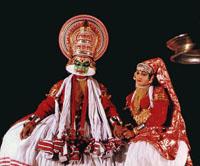 Kathakali is a very unique and unmatched form of art and is the most famous art form of Kerala. It is an art comprising a balanced combination of drama, music and dance. 'Katha' in Malayalam means story and 'Kali' means dance which shows that Kathakali depicts a story through dance. Kathakali is a very difficult art form to master and needs a lot of experience, dedication and talent. A lot of control has to be achieved in the movement of the body, eyes, hands, eye-lids, eyebrows and neck. It may take several years for a person to acquire perfection in Kathakali. Kathakali is a blended form of five art forms which includes Sahithyam (literature), Sangeetham (music), Chithram (painting), Natyam (acting) and Nritham (dance). As Kathakali comprises all the sections of art, it is famously known as a 'complete theatrical art form'. The acting part is done in mimes without any dialogues. As a result, elaborate and perfect facial expressions and perfect movement of gestures and mudras is needed to make the story understood to the audience. There is a kalamandalam (dance theatre) in the Cheruthuruthy district of Kerala where Kathakali is taught and is given the most importance. The art form depicts stories from the Ramayana and Mahabharata. One of the most famous Kathakali exponent is Tottam Sankaran Nambutiri.
Kathakali is a very unique and unmatched form of art and is the most famous art form of Kerala. It is an art comprising a balanced combination of drama, music and dance. 'Katha' in Malayalam means story and 'Kali' means dance which shows that Kathakali depicts a story through dance. Kathakali is a very difficult art form to master and needs a lot of experience, dedication and talent. A lot of control has to be achieved in the movement of the body, eyes, hands, eye-lids, eyebrows and neck. It may take several years for a person to acquire perfection in Kathakali. Kathakali is a blended form of five art forms which includes Sahithyam (literature), Sangeetham (music), Chithram (painting), Natyam (acting) and Nritham (dance). As Kathakali comprises all the sections of art, it is famously known as a 'complete theatrical art form'. The acting part is done in mimes without any dialogues. As a result, elaborate and perfect facial expressions and perfect movement of gestures and mudras is needed to make the story understood to the audience. There is a kalamandalam (dance theatre) in the Cheruthuruthy district of Kerala where Kathakali is taught and is given the most importance. The art form depicts stories from the Ramayana and Mahabharata. One of the most famous Kathakali exponent is Tottam Sankaran Nambutiri.
Kathakali is an after-dark or nocturnal performance. A big nilavilakku (a huge coconut-fed oil lamp) is placed in front of the artists. A piece of cloth called a tirasila is held by two persons as a curtain before the performance starts. Four instruments are mainly used namely, chenda, maddalam, chengila and elathalam. In this dance form, the actors do not speak but only act the padams (sections) through fitting symbols called mudras and facial expressions to the songs sung by the musician from behind. The songs used for Kathakali are composed in a language called Manipravalam (a combination of Tamil and Sanskrit). A very unique feature of Kathakali is its elaborate costumes and make-up system. The costumes consists of a huge and intricate headgear which is made from light-weight wood. The headgear is decorated with coloured stones and mirrors. The rest of the costume includes layers of skirts made of very bright colours. The artists also wear heavy gold jewellery. Those who are depicting evil characters such as demons wear beards and talons (big claws) which gives a more beastly appearance. The make-up comprises of five basic sets namely Pacha (meaning green), Kathi, Kari, Thaadi and Minukku. A Kathakali performance starts with a musical note called Thiranottam. The song that is sung for Kathakali is very unique and is separately called as sopaanam.
Kathakali has been developed and inspired from some of the traditional ancient South Indian dances such as Krishnattam, Koodiyattam and Theyyam. Initially, only Hindu themes taken from the Epics and Puranas used to be enacted but of late even non-Hindu themes are being performed. To begin with, Kathakali used to be performed throughout the night but lately this duration has been reduced to just two to three hours. Moreover, in earlier days, only men were allowed to perform in Kathakali. But nowadays even women have started to come into view in Kathakali presentations. In 1985, a Kathakali troupe was sent to Paris to give their performance at a show called Festival of India. In olden days, Kathakali used to be performed only in the courtyards of temples or at the King's palace but nowadays it is being performed at auditoriums and open grounds. Some of the people who are responsible for the development of Kathakali into such a famous art form are Kottakara Thampuran, Kaplingat Nambutiri, Karthika Thirunal Ramavarma, Vallathol Narayana Menon (the famous Malayalee poet) and Vidwan Tampuran of Kottayam.

You come with lot of good ideas & help all the people of kerala. As know in the air outside kerala Onam is still in air. This is a good reference to the people who wants to know about the dance in detail.